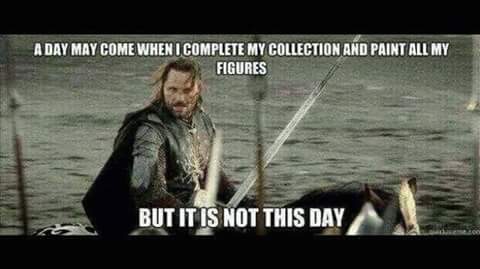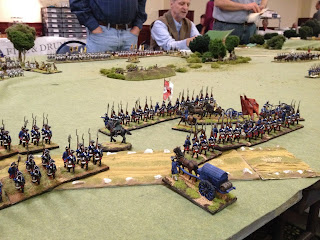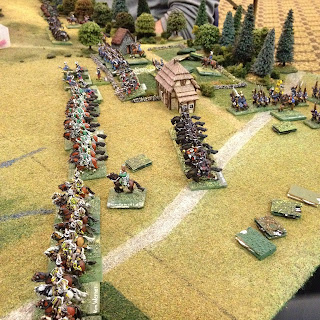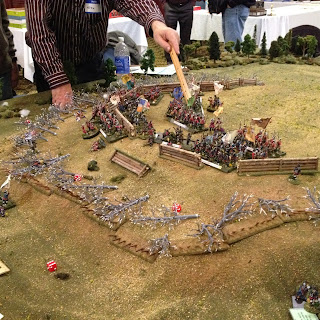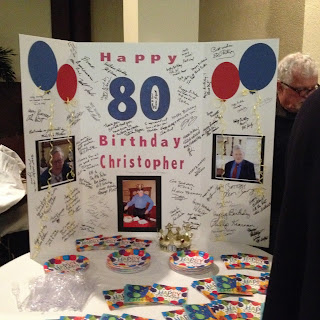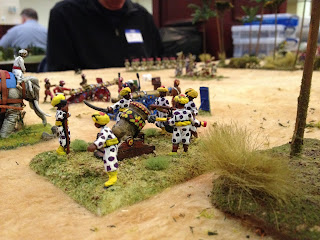We played "Hail Caesar," but since he wasn't alive yet we went with the Roman commander at the Battle of Asculum. This post will also act as a review of sorts for the game system.
The premise for the game was that Alexander hadn't died and somehow was still around to take on the Roman Republic. This allowed us to flesh out the painted Macedonians with Persian allies. The Romans had some Numidians and perhaps other mercenaries.
 |
| Behold! The Legions of Rome (and friends). |
 |
| And the Macedonians with Persian allies. |
 |
| And for me, something special. |
As is fashionable in today's gaming world, this is a dice-activated game. Unlike Black Powder you always get a base move and it is very easy to get multiple movement phases. It is an IGO-UGO game which also has: I move, I shoot (you don't), we melee, you move, you shoot, we melee. Units are assigned an impact dice value, a 2nd round of combat and beyond value, and stamina. In an effort to eliminate all book-keeping a unit accrues hits until is passes its stamina level and then is picked up. As part of the "dumbed down" approach (my opinion, you don't have to agree) a unit can be down to their last hit before being picked up, but still fight at full effectiveness.
 |
| Macedonian left of Persian Immortals. |
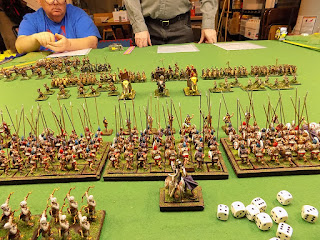 |
| The phalanx barely moved while the Romans raced forward. |
 |
| The Macedonian right, who feel they have the advantage. |
Since it is IGO-UGO the rules allow you to turn and face charges, even from behind. Unless of course you are pinned to the front by another unit. Melee results tally the hits given vs. taken and the difference determines the result. The loser tests and can carry on, fall back in good order, fall back disordered, fall back shaken, or even rout. Seemed pretty reasonable way of doing things.
 |
| Rumble, rumble, moving slow and trying to protect our flanks. |
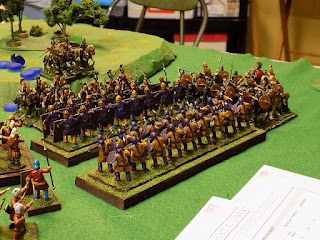 |
| Major cavalry and infantry scrum develops on the right. |
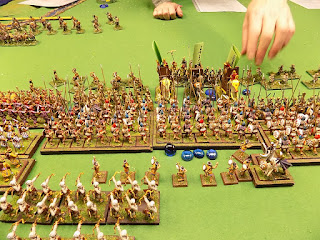 |
| Legionnaires and phalangites clash with a slight edge to the pikers. |
Missile armed troops get a defensive volley when charged. Usually not too many dice but if they roll a "6" then the charger has to pass a morale test. Since I was 0-2 on tests I think its a silly rule. Flippant attitude aside, it does seem strange that since they were usually rolling 2 or 3 dice that so many results occurred. I always try to visualize what could have "really" happened to give the result and I'm having a hard time rationalizing this one.
 |
One pike block went away, but Legionnaires are down and
elephants scattered in disorder. |
 |
| After a hard fight the left is victorious. |
 |
| Likewise the right is ready to sweep. |
The Pente stones represent hits, which can be removed (mostly) with rally orders. We had the luxury of doing so during the game and it really made a difference in the outcome. Both sides were hitting their "stamina" levels and were being picked up, but more from the Roman side than the Macedonian.
Shortly after these pictures were taken the Romans conceded. It would be interesting to see how it would have played out with another set of rules. All figures hit got a saving throw which ranged from a 6+ for light infantry to a 4+ on d6 for the Legionnaires. Why they got a better saving throw as armored close order infantry over the pikes (5+), armored close order infantry is beyond me.
So pros: pretty easy to pick the basic rules; variable movement keeps you for perfectly coordinating your army; plays to a conclusion fast; and the army lists seem pretty detailed.
Cons: Fight like you are fresh even if eliminated on the next hit; missile troops are very powerful; units just teleport away when they exceed their stamina level; and very high risk to leaders if they fight which seems contrary to historic examples.
At first as we played I was thinking, "it's nice to be playing ancients again" and started flipping through the army list books to see what it would take to recreate one of my old armies. By the end of the game I had dismissed the idea. I'd play it again, but I'm not building an army for Hail Caesar.
